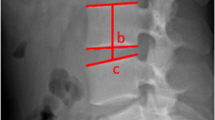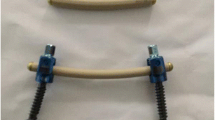Abstract
Background
Posterior lumbar instruments made of titanium and its alloys could change the physiological distribution of load at the instrumented and adjacent segments, which is a main cause of implant failure, non-fusion and adjacent segment degeneration. Posterior lumbar rods made of polyetheretherketone (PEEK) which is a semirigid alternative to titanium and its alloys have been introduced in lumbar fusion. This prospective study compared the radiological and clinical outcomes of patients undergoing lumbar fusion with PEEK rods versus titanium alloy rods.
Methods
Using transpedicular fixation and lumbar fusion, 21 patients were treated with titanium alloy rods (TI group), and 20 patients with PEEK rods (PEEK group). Radiological and clinical outcomes were evaluated, including the status of the implanted instruments, fusion rate, lumbar lordosis angle (LA), disc space height (DH), visual analog score (VAS) for lower back pain (VAS-BP) and leg pain (VAS-LP), Japanese Orthopedic Association scoring system (JOA score) and complications.
Results
Clinical VAS-BP, VAS-LP and JOA scores were significantly improved at 3 months, 6 months, and 1 year postoperatively as compared with preoperative scores in both groups (p < 0.05), with similar levels of improvement observed at the same time points postoperatively between the two groups. The overall fusion rate was 100 % at the 1-year follow-up for both groups. No significant differences in lumbar lordosis angle were found preoperatively, 1 week and 1 year postoperatively in both groups (p > 0.05). The postoperative increase of disc space height and loss of disc space height during the follow-up showed a similar extent of change between both groups (p > 0.05).
Conclusions
PEEK rods offer a similar radiological and clinical efficacy as titanium alloy rods. PEEK rods, as a semirigid implant with unique characteristics, may be an effective alternative treatment for patients with degenerative lumbar disease in lumbar fusion.



Similar content being viewed by others
References
Ahn YH, Chen WM, Lee KY, Park KW, Lee SJ (2008) Comparison of the load-sharing characteristics between pedicle-based dynamic and rigid rod devices. Biomed Mater 3:044101
Akamaru T, Kawahara N, Tim YS, Minamide A, Su KK, Tomita K, Hutton WC (2003) Adjacent segment motion after a simulated lumbar fusion in different sagittal alignments: A biomechanical analysis. Spine 28:1560–1566, Phila Pa 1976
Bono CM, Lee CK (2004) Critical analysis of trends in fusion for degenerative disc disease over the past 20 years: Influence of technique on fusion rate and clinical outcome. Spine 29:455–463, discussion Z5
Cho KS, Kang SG, Yoo DS, Huh PW, Kim DS, Lee SB (2009) Risk factors and surgical treatment for symptomatic adjacent segment degeneration after lumbar spine fusion. J Korean Neurosurg Soc 46:425–430
Chosa E, Goto K, Totoribe K, Tajima N (2004) Analysis of the effect of lumbar spine fusion on the superior adjacent intervertebral disk in the presence of disk degeneration, using the three-dimensional finite element method. J Spinal Disord Tech 17:134–139
De Iure F, Bosco G, Cappuccio M, Paderni S, Amendola L (2012) Posterior lumbar fusion by peek rods in degenerative spine: Preliminary report on 30 cases. Eur Spine J 21(Suppl 1):S50–54
Galbusera F, Bellini CM, Anasetti F, Ciavarro C, Lovi A, Brayda-Bruno M (2011) Rigid and flexible spinal stabilization devices: A biomechanical comparison. Med Eng Phys 33:490–496
Ghiselli G, Wang JC, Bhatia NN, Hsu WK, Dawson EG (2004) Adjacent segment degeneration in the lumbar spine. J Bone Joint Surg Am 86-A:1497–1503
Gornet MF, Chan FW, Coleman JC, Murrell B, Nockels RP, Taylor BA, Lanman TH, Ochoa JA (2011) Biomechanical assessment of a PEEK rod system for semirigid fixation of lumbar fusion constructs. J Biomech Eng 133:081009
Hasegawa K, Kitahara K, Hara T, Takano K, Shimoda H, Homma T (2008) Evaluation of lumbar segmental instability in degenerative diseases by using a new intraoperative measurement system. J Neurosurg Spine 8:255–262
Highsmith JM, Tumialan LM, Rodts GE Jr (2007) Flexible rods and the case for dynamic stabilization. Neurosurg Focus 22:E11
Iguchi T, Kanemura A, Kasahara K, Sato K, Kurihara A, Yoshiya S, Nishida K, Miyamoto H, Doita M (2004) Lumbar instability and clinical symptoms: Which is the more critical factor for symptoms: Sagittal translation or segment angulation. J Spinal Disord Tech 17:284–290
Kanayama M, Cunningham BW, Sefter JC, Goldstein JA, Stewart G, Kaneda K, McAfee PC (1999) Does spinal instrumentation influence the healing process of posterolateral spinal fusion? an in vivo animal model. Spine 24:1058–1065, Phila Pa 1976
Kotani Y, Cunningham BW, Cappuccino A, Kaneda K, McAfee PC (1996) The role of spinal instrumentation in augmenting lumbar posterolateral fusion. Spine 21:278–287, Phila Pa 1976
Kurtz SM, Devine JN (2007) PEEK biomaterials in trauma, orthopedic, and spinal implants. Biomaterials 28:4845–4869
Narayan P, Haid RW, Subach BR, Comey CH, Rodts GE (2002) Effect of spinal disease on successful arthrodesis in lumbar pedicle screw fixation. J Neurosurg 97(3 Suppl):277–280
Polly DW Jr, Santos ER, Mehbod AA (2005) Surgical treatment for the painful motion segment: Matching technology with the indications: Posterior lumbar fusion. Spine 30:S44–51
Ponnappan RK, Serhan H, Zarda B, Patel R, Albert T, Vaccaro AR (2009) Biomechanical evaluation and comparison of polyetheretherketone rod system to traditional titanium rod fixation. Spine J 9:263–267
Sagomonyants KB, Jarman-Smith ML, Devine JN, Aronow MS, Gronowicz GA (2008) The in vitro response of human osteoblasts to polyetheretherketone (PEEK) substrates compared to commercially pure titanium. Biomaterials 29:1563–1572
Sarbello JF, Lipman AJ, Hong J, Lawrence J, Bessey JT, Ponnappan RK, Vaccaro AR (2010) Patient perception of outcomes following failed spinal instrumentation with polyetheretherketone rods and titanium rods. Spine 35:E843–848, Phila Pa 1976
Smit TH, Muller R, van Dijk M, Wuisman PI (2003) Changes in bone architecture during spinal fusion: Three years follow-up and the role of cage stiffness. Spine 28:1802–1808, discussion 1809
Toth JM, Wang M, Estes BT, Scifert JL, Seim HB 3rd, Turner AS (2006) Polyetheretherketone as a biomaterial for spinal applications. Biomaterials 27:324–334
Toyone T, Takahashi K, Kitahara H, Yamagata M, Murakami M, Moriya H (1993) Visualisation of symptomatic nerve roots. Prospective study of contrast-enhanced MRI in patients with lumbar disc herniation. J Bone Joint Surg Br 75:529–533
Turner JL, Paller DJ, Murrell CB (2010) The mechanical effect of commercially pure titanium and polyetheretherketone rods on spinal implants at the operative and adjacent levels. Spine 35:E1076–1082, Phila Pa 1976
Wedemeyer M, Parent S, Mahar A, Odell T, Swimmer T, Newton P (2007) Titanium versus stainless steel for anterior spinal fusions: An analysis of rod stress as a predictor of rod breakage during physiologic loading in a bovine model. Spine 32:42–48, Phila Pa 1976
Zhou ZJ, Zhao FD, Fang XQ, Zhao X, Fan SW (2011) Meta-analysis of instrumented posterior interbody fusion versus instrumented posterolateral fusion in the lumbar spine. J Neurosurg Spine 15:295–310
Conflicts of interest
None.
Author information
Authors and Affiliations
Corresponding author
Additional information
Comment
Transpedicle screw and rod instrumentation has become the preferred technique for performing stabilization and fusion in the treatment of degenerative lumbar spine disease. The authors now have added a relevant and well-done study to this field of spinal surgical management. In their series, 41 patients suffering from lumbar degenerative disease were treated using either a polyetheretherketone (PEEK) or titanium alloy rod system for single level posterior fusion. Meanwhile, it was demonstrated that PEEK rods have a similar high fusion and low reoperation rate when compared to previous instrumentation modalities (1,3). Furthermore, PEEK rods confer similar clinical efficacy as titanium alloy constructs and their semirigid properties, combined with their radiolucency, suggest that PEEK rods have even some advantages over titanium alloy rods for application in posterior lumbosacral instrumentation. However, the biomechanical effects of implantation of stabilization systems limit the range of motion and produce an unforeseeable nonphysiological stress on the operated functional spinal unit when compared to the nonoperated and intact spine. Additionally, the centre of rotation and stress distribution might differ according to the design and material of the implants used (2). Therefore, the indication for the necessity of spinal instrumentation and fusion should be assessed with scrutiny and the potential biomechanical effects of current materials and systems applied should be carefully considered before final clinical implementation.
References
1. Bruner HJ, Guan Y, Yoganandan N, Pintar FA, Maiman DJ, Slivka MA (2010) Biomechanics of polyaryletherketone rod composites and titanium rods for posterior lumbosacral instrumentation. Presented at the 2010 Joint Spine Section Meeting. Laboratory investigation. J Neurosurg Spine 13:766-772
2. Jahng TA, Kim YE, Moon KY (2013) Comparison of the biomechanical effect of pedicle-based dynamic stabilization: a study using finite element analysis. Spine J 13:85-94
3. Ormond DR, Albert L Jr, Das K (2012) Polyetheretherketone (PEEK) rods in lumbar spine degenerative disease: a case series. J Spinal Disord Tech Oct 16. [Epub ahead of print]
Markus F. Oertel
Bern, Switzerland
Rights and permissions
About this article
Cite this article
Qi, L., Li, M., Zhang, S. et al. Comparative effectiveness of PEEK rods versus titanium alloy rods in lumbar fusion: A preliminary report. Acta Neurochir 155, 1187–1193 (2013). https://doi.org/10.1007/s00701-013-1772-3
Received:
Accepted:
Published:
Issue Date:
DOI: https://doi.org/10.1007/s00701-013-1772-3




